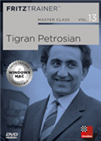E. Geller - B. Spassky, 1964
In the first example, Spassky overruns the top Soviet player Efim Geller with Black. Geller (2 March 1925 - 17 November 1988) was one of the best players in the world for three decades, from the early 1950s to the end of the 1970s. During his career he achieved a favourable record against Mikhail Botvinnik (+4 =6 -1), Vasily Smyslov (+11 =37 -8), Tigran Petrosian (+6 =36 -3) and Bobby Fischer (+5 =2 -3) and qualified six times for Candidates Tournaments or Candidates competitions. In 1979, at the age of 54, he won the Soviet Championship, and in 1992 he became Senior World Champion in Bad Wörishofen.
 In this video course, experts including Dorian Rogozenco, Mihail Marin, Karsten Müller and Oliver Reeh, examine the games of Boris Spassky. Let them show you which openings Spassky chose to play, where his strength in middlegames were and much more.
In this video course, experts including Dorian Rogozenco, Mihail Marin, Karsten Müller and Oliver Reeh, examine the games of Boris Spassky. Let them show you which openings Spassky chose to play, where his strength in middlegames were and much more.Geller, who had a doctorate in economics and was a passionate basketball player before his chess career, was regarded as an excellent expert in openings and an outstanding analyst. He was a perfectionist, and his search for the best move put him in time trouble in many games. But in return he was a sought-after second who worked with players such as Petrosian, Spassky and Karpov.

Efim Geller, 1977 | Photo: Koen Suyk / Anefo - Dutch National Archives, The Hague, Fotocollectie Algemeen Nederlands Persbureau (ANeFo), 1945-1989
His relationship with Spassky was complex; they were colleagues and rivals. Geller lost twice to Spassky in the 1965 and 1968 Candidates matches, but in 1969 he supported Spassky in his World Championship match against Petrosian, and in 1972 he was Spassky's second in his World Championship match against Fischer in Reykjavík.
In his games against Spassky, however, Geller often had difficulties and his overall record of +6-10=22 against Spassky is worse than Geller's record against other world champions. He had a surprising explanation for this: "Boris was always so friendly to me, as a person and as a player, that I never felt any real sporting bite in me..." (Shakhmaty v Rossii, April 1997, quoted in: Andrew Soltis, Tal, Petrosian, Spassky and Korchnoi: A Chess Multibiography with 207 Games, McFarland 2019, p. 264).
However, there is no sign of friendliness in the following game.
B. Spassky - T. Petrosian, WM-Kampf 1969
Spassky played his first World Championship match in 1966, but narrowly lost to defending champion Petrosian 11½-12½. Three years later, in his second World Championship match against Petrosian in 1969, he did better: Spassky won 12½-10½ and became the 10th world champion in chess history.
 Considered a master of prophylaxis, Petrosian sensed dangers long before they actually became acute on the board. In his prime, Petrosian was almost invincible. Let our authors introduce you into the world of Tigran Petrosian.
Considered a master of prophylaxis, Petrosian sensed dangers long before they actually became acute on the board. In his prime, Petrosian was almost invincible. Let our authors introduce you into the world of Tigran Petrosian.
Tigran Petrosian, world champion from 1963 to 1969 | Photo: Harry Pot, Nationaal Archief, Den Haag, Rijksfotoarchief: Fotocollectie Algemeen Nederlands Fotopersbureau (ANEFO), Quelle: Wikipedia
In one of his best games in the second match, Spassky outplayed Petrosian positionally and then crowned the game with a beautiful queen sacrifice.
If you like, this game was revenge for a spectacular defeat that Spassky had suffered three years earlier in the tenth game of his first World Championship match against Petrosian. In this famous game, Petrosian sacrificed an exchange twice and culminated his strong play at the end with a pretty, if not complicated, queen sacrifice.
B. Spassky - R. Kholmov, 1971
But in his career, it was Spassky who had the pleasure of sacrificing his queen more times than Petrosian. For example, in the following game against Ratmir Kholmov, one of the Soviet Union's strongest players from the mid-1950s to the mid-1970s.

Ratmir Kholmov (13 May 1925 – 18 February 2006)
But Kholmov was considered politically unreliable and so, despite his playing strength, he was only allowed to travel to tournaments in socialist countries, but he was still ranked number 8 in the world from August 1960 to March 1961 according to Chessmetrics.com. However, in 1971 he suffered a terrible defeat against Spassky in the final of the Soviet Team Championships in Rostov-on-Don.
This was not the only game in which Spassky sacrificed his queen on h6. He had also achieved this feat back in 1968 in the final of the Candidates Competition against his long-time rival Viktor Korchnoi...
...whom he mated here with 35.Qh6+.
And Spassky was also successful against the Yugoslav grandmaster Dragoljub Ciric at the 1970 GM tournament in Amsterdam - with, again, a queen sacrifice on h6.
Spassky finished his attack in style: 28.Qxh6! and after 28...Nf6 29.Rxf6! Black resigned.
You can find even more queen sacrifices and spirited attacks by Spassky in the ChessBase Masterclass on Boris Spassky.
In this video course, experts including Dorian Rogozenco, Mihail Marin, Karsten Müller and Oliver Reeh, examine the games of Boris Spassky. Let them show you which openings Spassky chose to play, where his strength in middlegames were and much more.
Links
























